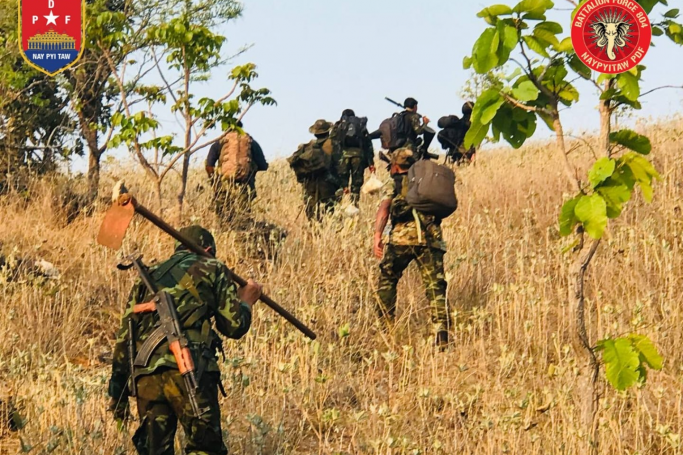A question has been raised as to whether Myanmar resistance forces operating in the Bago Region pose a threat to the Myanmar generals residing in the capital Naypyidaw.
The question comes as the National Unity Government (NUG) hypes up the rhetoric in its war against the illegal military government that grabbed power in 2021.
The NUG’s Minister for Defence said in June that their resistance forces are carrying out offensives throughout the country, and have begun their mission of “All Roads Lead to Naypyidaw”.
After this declaration by the NUG, the Military Council reportedly tightened security at the capital’s security checkpoints and increased its defensive capacity.
How much is this a threat to the capital and how much is the rhetoric of war?
The NUG said that since early 2023, armed conflicts between the Military Council and the joint forces of ethnic revolution organisations (EROs) and People’s Defence Forces (PDFs) have intensified in Bago Sub-military command that is included in Southern Military Command of the NUG.
The PDFs conducted guerilla warfare against military troops between 2021 and 2022, but now in 2023, they are launching counterattacks and offensives, the NUG says.
The uptick has prompted military analysts to remark that as Bago Region borders Naypyidaw, armed struggle in this region is “threatening the capital of the military generals”.
INCHING CLOSER
Whether this is a serious threat is unclear but the actions of the resistance forces over the last two years have prompted the Military Council to tighten defences.
The Southern Command of the NUG said that battalions from Bago Region Command are fighting with its battalions and the KNU’s forces against the military.
A spokesperson for the KNU, Padoh Saw Kale Say, told Mizzima that the geographical factor of Bago Region is strategically important for the Military Council.
“We found that Bago Region is strategically vital for the Military Council in terms of their administration, power and military operations for their control in lower Myanmar,” he said.
Political and military analyst Than Soe Naing said that as the eastern part of Bago is located between Naypyidaw and Yangon, the control of resistance forces in this area will cause an escalation of battles.
“Bago and Naypyidaw are like a head and neck of a body. The resistance forces could threaten the military if they control Bago Region,” he remarked.
Armed clashes have occurred in all 28 townships of Bago Region after the military took power. Out of 14 townships in the eastern part of Bago, armed conflicts are intensifying in Yedashe, Taungoo, Kyaukkyi, Kyauktaga, Nyaunglaybin and Shwegyin townships, while the western Bago townships of Paungde, Okpa, Nattalin and Minhla frequently suffer from armed clashes.
THREATENING THE CAPITAL?
Resistance activity in Bago is not the only threat to Naypyidaw. The capital is surrounded by Shan State in the east, Mandalay in the north, Magway in the west, Bago in the south and Karenni State in the southeast.
Armed clashes are now escalating in Karenni State, the Shan-Karenni border and Bago Region at present. The KNU and the NUG Ministry of Defence stated that there were many casualties in July amongst Military Council troops during armed conflicts in the eastern part of Bago and Yedashe, which is very close to Naypyidaw.
Moreover, joint forces of the EROs and PDFs blew up the Nat Than Gwin Bridge which is crucial for junta military logistical support in 2023.
Ko Wai Yan, a spokesperson of the Bago region Sub-military command, said to Mizzima: “The military took advantage of their air force in Bago Region, while the advantage of our resistance force is public support.”
An official of a PDF battalion in eastern Bago Region told Mizzima that good results on the missions depend on the participation of the public, noting: “Public support is crucial for our victory.”
Ko Wai Yan claimed that resistance forces in Bago Region are successfully threatening Naypyidaw.
“Our forces are capable of entering Naypyidaw in an hour. The conflicts in Bago region are threatening Naypyitaw,” he said.
Although the Military Council has 11 divisions, each of them has a declining capacity at present, said analyst Than Soe Naing.
A convoy from the Quartermaster General was attacked by resistance forces on the Yangon to Mandalay highway between Yangon and Mandalay last month. Since then, the Military Council has tightened security on this route.
Armed conflicts have significantly intensified in the first seven months of this year. Local resistance forces and military analysts remarked that conflicts are expected to increase in the coming months and will spread to Naypyidaw.
“Military activities of resistance forces in Bago Region can support more operations of the alliances. Although decisive battles may not occur in every place, collaborative efforts will make strategic objectives successful,” Than Soe Naing told Mizzima.
All roads may lead to Naypyidaw, as the NUG makes clear, but the practicalities of invading the capital pose a serious challenge for Myanmar’s resistance forces.












